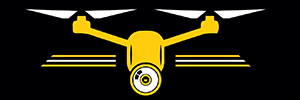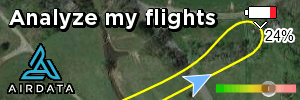A few things to consider before painting propellers.
1) what is the propeller material?
2) Is it already painted?
3) Weight and evenness of the coating?
4) painting considerations
5) surface prep and painting
1) What is the propeller material? unless metal, they will be polymeric or carbon fiber. For little propellers carbon fiber is not really an option, but carbon reinforced is. Most polymers will soften or swell from strong solvents like acetone, xylene, methyl ethyl ketone... they are common solvents in nail polish or spray paint. Due to different thicknesses of the propeller, swelling will not be equal and can warp the propeller. I am not saying it will be noticeable in flight, but there may be loss of propeller efficiency. That is the bad, the good is the swelling may soften the polymer of the blade and allow the paint to adhere better.
2) Is it already painted? Add in has it been used. If it is already coated, how solvent resistant is the coating? If the topcoat (paint you are using) uses a stronger solvent than the basecoat (coating already on), the solvent may swell or dissolve the basecoat. If the basecoat swells, it will generally wrinkle and lift off the substrate. If it dissolves or wrinkles the new paint may stick to the old paint, but the basecoat may not stick to the substrate. Loss of adhesion between coats is know as intercoat adhesion failure. If the propeller is used or new how the paint will stick will be different. New propellers may have mold release agent on them (normally silicone based), and the coating will not stick to the mold release. Mold release is used so the part drops out of the mold without sticking, so makes the surface very low energy, so coatings will not adhere to it. If the blade was used, there may be contaminants on the blade from the air (dust pitting the propeller microscopically, bug guts, oily fumes depositing on the blade...) so I recommend only painting new blades for a consistent substrate.
3) Weight and evenness of the coating? I mixed up some blade pairs (being a newbie, did not know it made a difference) so I brought them to the lab and weighted them on a balance that goes to .0001 gram I noticed the 2 different blades shapes had different weights, but the weight of the blades with the same shape were very consistent. When I weighted out 2 more matched pairs I noticed the same shape blades had a weight difference of about 0.002 grams but the weight between the the 2 shapes was different. The difference between the 2 blade shapes was about 0.02 grams or 10 times the variation in weight difference for the same shape, so not production difference but designed that way. This is all for a
Mini 4k. This got me thinking that there must be a reason they say not to mix up blade pairs. The motor turns one way so you may need a certain weight difference on the blades to remove rotational torque forces on the motor. So what does this have to do with paint? If the paint is now applied will you add more weight to one propeller than another? Will this throw off motor balance? I do not know, but it is something to think about.
4) Painting considerations? a few things to think about.
Does the plastic blade contain plasticizers? Plasticizers are liquid fillers added to plastic to both reduce cost and make the plastic softer. When using a solvent based coating, will the solvent extract plasticizers from the blade and make it more brittle.
Will added weight of the coating put extra forces on the drive train of the drone and wear parts faster?
Will the coating have a smoother or rougher surface that will change the air flow over the blade?
If the paint chips, will irregular airflow from the rough surface change propeller efficiency?
Make sure the paint is more flexible than the blade or when the blade flexes, the paint will crack or peel off.
Paint has a recoat window, most paints will have a statement like "recoat before x hours or after x days" this is to only coat when the layer below it is ready to accept a new coat, not following this will lead to failure.
5) Surface prep and painting. The most important part of the painting process is preparing the surface. Here is how I would do it (your mileage may vary).
I would start washing the blades with trisodium phosphate (TSP), the real stuff not the eco-friendly substitute. Follow the instructions and I recommend gloves. This will remove any mold release agent or contamination from the blade. Rinse well with water afterwards.
Test to see if the paint sticks. Use an blade and paint it. Then bend the blade, flex the blade, scratch it with your fingernail once it has dried... if it sticks you are good if not, go to an auto parts store and buy some bumper/plastic adhesion promoter, it comes in a spray can. Spray a very thin coat on and let it cure.
Paint is a whole other issue. Most paints are formulated to hide at a specific thickness, so a lot of normal spray paints will require too thick of a coating for blades (think weight and uneven coating thickness on the blade since it drips.) The options for heavily pigmented paints that cover/hide in thin coat are either nail polish or artist/model paint. I recommend spray since it will give a more even coat compared to brush on. Companies like Tamiya make model paint in spray cans, it is heavily pigmented so will cover in a thinner coat and designed for coating plastic. I recommend solvent based over water based since the lower surface tension of solvents will allow a thinner more even coat. A few thin coats will give a more consistent coating than 1 thick coat.
I hope this helps.










